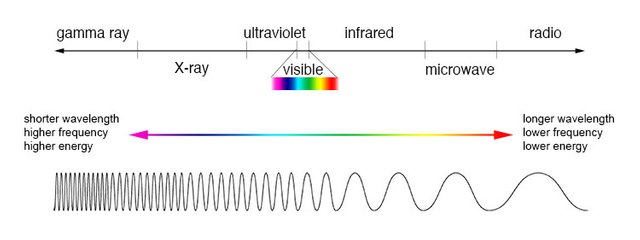Let's Learn Something Cool - My Red Is Not The Same As Yours
Inspired by yesterday's post on Mars' blue sunset, I decided to bring this out today:
(Image by @ruth-girl)
The world is a palette of endless colors and shades. Red, scarlet, crimson, ruby, blue, aquamarine, azure and so on... But do we all see the same colors regardless their name?
It's all an illusion!
Yes, my friends. We 've been lied to all this time. The hot blondie you were checking out the other day only looks blond to you. Those magnificent suede burgundy red heels you've been saving to buy for Christmas are not as red as you think. And no, my troll does not have purple hair, because all these are only images created in our brains!
Woman, are you high?
No, I 'm not. I don't do drugs and neither should you, the point is that colors do not exist beyond our brains. They are rather the abilty of our visual system to perceive them as such. Our eyes bear specific receptors called rods and cones that are responsible for the images we "think" we can see.
Let's take it from the very beginning
Light (photons) is a particle and a wave, meaning that it has a wavelength. Humans are able to perceive only certain wavelengths of the electromagnetic spectrum (there are so much we miss in the invisible world, thank God there is technology to make up for it). Objects have the ability to absorb and reflect light. Absorbing specific wavelengths and reflecting others is what gives those objects their distinguishing color.

(Image from: wikimedia.org)
Our eyes are equipped with receptors called rods and cones. Rods are the ones responsible for vision in low-light conditions (in other words scotopic vision). Cones are divided into three categories depending on the wavelengths they are most sensitive at: s-cones (for short-wavelength light, blue), m-cones (for medium-wavelength light, green) and l-cones (for long-wavelength light, red) [2]. Every color comes from the combination of those three. These receptors get excited from the light that reaches our eyes and then send the signal to our brain through a vast network of neurons. Our brain is then able to synthesize those signals and form a final decision on what color it can "see". When this equipment is damaged then there are people whose "color palettes" deviate from the norm.

(Image from:commons.wikimedia.org)
A study from the University of Rochester in 2006 showed that, despite the variability in nature (the number of cones is not the same for all of us) we get to perceive colors the same way. Color, though, has to do with a more general consensus based on what we decide to call yellow, red or blue. Our experiences and environment are responsible in defining a particular wavelength as pure yellow or pure green [5].
Another experiment performed on monkeys showed that color perception is related to our environment and visual stimuli we get, but our brains are not born with a default mechanism. We get to adjust our color perception according to our "equipment". This experiment has raised hopes in fixing certain malfunctions on human eyesight, rendering possible for people with problematic eyesight to gain access to a wider spectrum range.
One last fascinating fact is that another study has revealed how melanopsin in the ipRGC cells of the eye retina affect human's emotions and circadian rythm. A remnant of man's ancient brain, melanopsin, signals the brain to create specific emotions upon seeing certain wavelengths. For example, shorter wavelengths (blue) make us feel calm and relaxed, that's why a walk by the sea might help reduce stress. Longer wavelengths (red and orange) make us more alert and energetic (now the idiom "see red" makes more sense) [1] and [6].
If you want to learn more on the anatomy and function of the eye, you can follow this link from micro.magnet.fsu.edu
Here is a short video on how our eyes see colors
And because I like this song, I'll leave this here (since the title matches the image in the beginning "Πήρα Κόκκινα Γυαλιά" - "I Bought Some Red Glasses":
References
[1] livescience.com
[2] workwithcolor.com
[3] cis.rit.edu
[4] khanacademy.org
[5] sciencedaily.com
[6] ncbi.nlm.nih.gov
Thank you very much for being here! I appreciate your support. If you want to see more of my posts, check some of the links below:
- Diamonds And Rust - A Short Story Of Science Fiction
- Bizarre Natural Phenomena Vol.37 - Cold And Dirty "Lava" (Mud Volcanoes)
- Trolls Around The Solar System - Part 3, Mars
- A Christmas Present For Alice - A Short Story Of Fantasy
- Bizarre Natural Phenomena Vol.36 - Diamonds In The Sky (Diamond Dust And Optical Illusions)
Until my next post,
Steem on and keep smiling, people!




"I don't do drugs and neither should you"
It's a little late in my career for you to be telling me that :-)
But I'm sure you have a very "scientific" reason for doing so!
Just to be on the safe side in case policemen are reading this :P
What do you mean "in case"? Of course they are.
Now you're either one of them or bluffing to scare me... I put my bets in bluffing (see? drugs and gamble, two birds with one stone :P )
You have been getting your birds stoned? Officer, arrest her!
Great! Now you got animal abuse on the list... Happy Behind-Bars-New Year! :(
Lol...
Please disregard @twiceuponatime. He is very brazen.
I, on the other hand would get the police to pondering what it would be like to look through a fly's eyes. After thinking about it for a while, they would want some drugs too!
Congratulations! This post has been upvoted from the communal account, @minnowsupport, by ruth-girl from the Minnow Support Project. It's a witness project run by aggroed, ausbitbank, teamsteem, theprophet0, someguy123, neoxian, followbtcnews/crimsonclad, and netuoso. The goal is to help Steemit grow by supporting Minnows and creating a social network. Please find us in the Peace, Abundance, and Liberty Network (PALnet) Discord Channel. It's a completely public and open space to all members of the Steemit community who voluntarily choose to be there.
If you would like to delegate to the Minnow Support Project you can do so by clicking on the following links: 50SP, 100SP, 250SP, 500SP, 1000SP, 5000SP. Be sure to leave at least 50SP undelegated on your account.
I was always wondering how different people experience the "bokeh", that blur of the distant, unfocused lights. After examining several of my friends, they described them a bit differently
Cool experiment to do with my friends! Thanks for the idea! :)
We love the trick the brain plays at us showing us things the eyes see the way the brain "sees" it.
We love our world or at least the version our brain can "see" :P
It is all about photoelectric effect discovered by my scientific hero, Einstein.
Exactly! Thanks for reading!
Και μαθαίνουμε και διασκεδάζουμε με το χιούμορ σου !
Καλή και δημιουργική χρονιά να έχεις !
resteem
Ευχαριστώ πάρα πολύ! Επίσης!!! Το 2018 σου να είναι όμορφο!!
Back in elementary school, long before the "are you high?" question was appropriate, I recall having the revelation that color was a socially-constructed concept, and stumbling Lebowski-like through my explanation to peers (But, like, you can't ever see through my eyes, man). I was passionate about the neurology and sensory integration once I reached that level of biological study and this is a great discussion of the phenomenon of color perception.
Along the vein of color pecerception, a recent trend that I have been enjoying are videos of people with red-green color blindness observing their surroundings while wearing special eyewear that reduces the extra overlap that occurs in the photopigments perceived by the cones of their eyes. It is always paired with extreme emotion when confronted with the idea that even though we have the same hardware (eyes), we also need accurate functioning of the software (brain) to get the job of perceiving all the entire spectrum done.
The funny thing about color being a construction is how people who saw certain wavelengths as yellow for example, changed their perception after wearing special lenses. It's remarkable how you can mess with someone's brain.
As for the videos you mentioned, I have seen a few. Their feelings must be indescribable when they start seeing like "normal" people, like they enter a whole different reality.
Thanks for reading! :)
Isn't that the APA's tagline? /s
We have to trust our brain to try to help make sense of the world in most situations, but it can't get it all right every time!
Exactly. But there's also a very rare condition "tetrachromacy". These people possess four independent cones instead of three. I wonder how they see colours. But I heard they can distinguish between millions of shades of a particular colour :)
This must be really awesome! I'll check it out. Also very amazing is how animals perceive colors. There is no such thing as an absolute reality, it has many faces and shows a different one to all of us :)
Exactly. There's no such thing as absolute reality
ive definitely heard of this before. Isn’t it crazy how we all see the world different and that there’s no way to really see it through someone else’s eyes?
It is! I mean most people expect to see different from animals, but seeing different from other people can sound strange.
Very educative post. I completely agree that colors don't exist beyond our brain. I also try to educate steemit members about health because only with knowledge this community can grow:)
Thank you so much for reading! :)